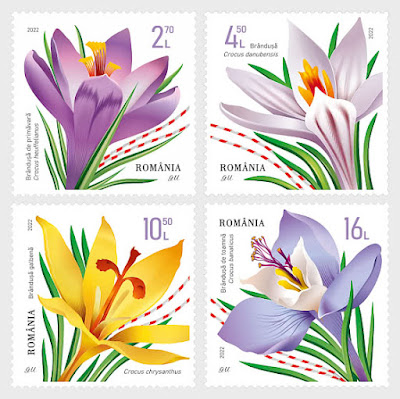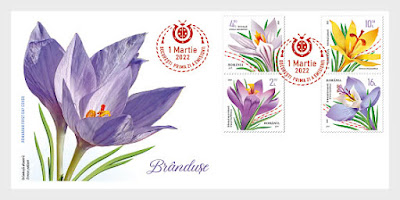2260) "Crocuses", Romania: A set of four stamps issued by Romfilatela (Romanian Post) depicting four species of Crocuses - Crocus pallasii (FDC), Spring crocus (Crocus heuffelianus), Crocus crysanthus (Golden Crocus), Autumn crocus (Crocus banaticus),Crocus (Crocus danubensis): Date of Stamp Set issue: 01.03.2022:
About Crocuses:
On March 1st, the first day of Mărțișor ("March Amulet") and spring, Romfilatelia has put into circulation a set of postage stamps depicting - Crocuses.
Among most people, the crocus is a flower symbol of strong feelings of love and devotion.
Many legends were born about it two of which are most popular - the twin sisters who will never be able to meet and that of St. Valentine, whose execution day (February 14) is celebrated as "Lover's Day":
One of them shows the two crocuses, the spring one and the autumn one, as two twin sisters, whom the stepmother Earth drove away. One in an early spring, the other in a late fall. Seeing them sore, God turned them into flowers. Since then, they have been looking for each other, without ever being able to meet.
Another legend, sprung from the healing properties of the crocus, has as subject the autumn crocus. The legend has as main character Saint Valentine, who, upon being imprisoned, fell in love with the blind daughter of a jailer. The saint sent that girl a crocus with miraculous healing powers.
The first images that the girl discerned were that of the crocus and that of the missive that he had sent, on which were written the words that became famous, “From your Valentine”. For centuries, Saint Valentine’s Execution Day, February 14th, has been celebrated as Lovers’ Day.
At springtime:
Signs of spring, the crocuses charm the view through the spots of colour during a season when trees, shrubs and summer flowering species are still dormant. They are admired plants and a source of inspiration for many artists, being mentioned in world literature and are present in gastronomy and medicine.
Regarding the origin of the genus, current research shows that it is native to North Africa, being found in the Iberian Peninsula, the Balkans and Anatolia.
Crocuses belong to the genus Crocus, a genus belonging to the family Iridaceae, which includes 247 species and subspecies and extends longitudinally from the Iberian Peninsula to China and latitudinally from Poland to the Caucasus and the northern part of the Arabian Peninsula; most species can be found in the Balkans and Turkey.
In Romania, the most common species of the spontaneous flora are the spring crocus (Crocus heuffelianus) and the autumn crocus (Crocus banaticus).
The species Crocus pallasii, Crocus crysanthus, Crocus Flavius and Crocus danubensis are protected by national laws of Romania.
The four postage stamps of the “Crocuses” issue reproduce images of the flowers known as:
Spring crocus (Crocus heuffelianus), illustrated on the stamp with the face value of Lei 2.70.
It is very common in mountain meadows and is distinguished by the lilac corolla with a characteristic, V-shaped pattern on each tepal.
Crocus (Crocus danubensis), rendered on the stamp with the face value of Lei 4.50.
It grows in dry meadows, especially in the south of the country and blooms in early spring, even in February. It is distinguished by the purple stripes arranged longitudinally on the outside of the tepals.
Golden crocus (Crocus crysanthus), represented graphically on the stamp with the face value of Lei 10.50.
It blooms in early spring through meadows and bushes in Dobrogea. The flowers are golden yellow, the name of the species being very suggestive in this respect. Sometimes white flowering plants of the same species can be found.
Autumn crocus (Crocus banaticus) with a face value of Lei 16.00:
It differs from other species of crocusess in that three of the tepals, the internal ones, are different in shape and color. The outer tepals are lilac-blue. They bloom through meadows, bushes and forest edges in the central and western parts of the country. It differs from the autumn colchicum of the genus Colchicum in the number of stamens (3 in the species of the genus Crocus, 6 in those of Colchicum).
On the First Day Cover (FDC) of the issue is illustrated an blue crocus (Crocus pallasii) at left.
It grows only in Dobrogea, through stony meadows. It blooms in autumn and is very similar to saffron (Crocus sativus), a species of toad from which we have the most expensive spice.
The Miniature Sheet (MS)
Sheetlets of five stamp each and a coupon/label of each variant
Full Sheets of 28 Stamps of each variant
Technical details:
Issue Date: 01.03.2022
Designer: George Ursachi
Process: Offset
Colours: 4 Colours
Size:
Stamp size: 36 x 36 mm
Minisheet size: 130 x 100 mm Special block size: 120 x 120 mm
Values: 2.70, 4.50, 10.50, 16.00 Lei
Links to Posts on "European Year of Rail":
17) Institute of Speleology (Study of Caves) "Emil Racovita", Romania: A Century of Research (1920-2020): A set of four stamps issued by Romfilatelia (Romanian Post) featuring representative images of Caves of Romania which are of great importance for Speleological Research & Activity: Date of Stamp set issue: 18.06.2020





Santosh Khanna has commented:
ReplyDelete"Interesting informative post. Thanks for sharing."
Thank you so much, Khanna sahab.
DeleteRajan Trikha has commented:
ReplyDelete"Very interesting 👍"
Thank you, Trikha sahab.
Delete